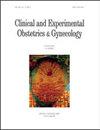Does Vaginal Estriol or Hyaluronic Acid Facilitate Office Hysteroscopy in Peri and Postmenopause? A Prospective Cohort Study
IF 0.6
4区 医学
Q4 OBSTETRICS & GYNECOLOGY
引用次数: 0
Abstract
Background: Pain accompanying office hysteroscopy, possibly aggravated by urogenital atrophy, is the most common reason for its discontinuation. The aim was to evaluate the effectiveness of vaginal estriol and hyaluronic acid to facilitate the office hysteroscopy in peri and postmenopausal women. Methods: A prospective cohort study involved women aged 45–90 years subjected to office hysteroscopy. Women were assigned to three study arms: (A) 0.5 mg of estriol in vaginal cream twice daily for 10 days pre-procedure, (B) 5 mg of hyaluronic acid in vaginal gel twice daily for 10 days pre-procedure, (C) no medication. The following endpoints were compared: pain accompanying the procedure, need for cervical dilation, time of cervical passage, incidence of severe urogenital atrophy, and vaso-vagal reaction. Results: There were no significant differences between the arms in terms of pain intensity during (p = 0.93) and after the procedure (p = 0.17), need for cervical dilation (p = 0.5), cervical passage time (p = 0.1), severe urogenital atrophy (p = 0.15), and vaso-vagal reaction (p = 0.29). Conclusions: Despite unfavorable conditions in peri and postmenopausal women, cervical preparation in the above regimens did not seem to bring clinically significant benefits. Clinical Trial Registration: The study was registered under the number NCT05783479 in the Protocol Registration and Results System database (https://clinicaltrials.gov/). The database used for the study was made available in Harvard Dataverse (https://doi.org/10.7910/DVN/HSWURD).阴道雌三醇或透明质酸是否有助于绝经前后宫腔镜检查?一项前瞻性队列研究
背景:宫腔镜手术中伴随的疼痛,可能因泌尿生殖萎缩而加重,是宫腔镜手术中断的最常见原因。目的是评价阴道雌三醇和透明质酸对围绝经期和绝经后妇女宫腔镜检查的效果。方法:一项前瞻性队列研究涉及45-90岁的妇女接受宫腔镜检查。女性被分为三个研究组:(A)手术前10天,阴道乳膏中含有0.5毫克雌三醇,每天两次;(B)手术前10天,阴道凝胶中含有5毫克透明质酸,每天两次;(C)不服用药物。比较以下终点:手术伴随疼痛、宫颈扩张需要、宫颈通过时间、严重泌尿生殖系统萎缩发生率和血管迷走神经反应。结果:两组患者术中疼痛强度(p = 0.93)与术后疼痛强度(p = 0.17)、宫颈扩张需要(p = 0.5)、宫颈通过时间(p = 0.1)、严重泌尿生殖系统萎缩(p = 0.15)、血管迷走神经反应(p = 0.29)差异均无统计学意义。结论:尽管对围绝经期和绝经后妇女不利,上述方案中的宫颈准备似乎并没有带来显著的临床益处。临床试验注册:该研究在方案注册和结果系统数据库(https://clinicaltrials.gov/)中注册,注册号为NCT05783479。该研究使用的数据库可在Harvard Dataverse (https://doi.org/10.7910/DVN/HSWURD)上获得。
本文章由计算机程序翻译,如有差异,请以英文原文为准。
求助全文
约1分钟内获得全文
求助全文
来源期刊
CiteScore
0.50
自引率
0.00%
发文量
241
审稿时长
1 months
期刊介绍:
CEOG is an international, peer-reviewed, open access journal. CEOG covers all aspects of Obstetrics and Gynecology, including obstetrics, prenatal diagnosis, maternal-fetal medicine, perinatology, general gynecology, gynecologic oncology, uro-gynecology, reproductive medicine, infertility, reproductive endocrinology, sexual medicine. All submissions of cutting-edge advances of medical research in the area of women''s health worldwide are encouraged.

 求助内容:
求助内容: 应助结果提醒方式:
应助结果提醒方式:


